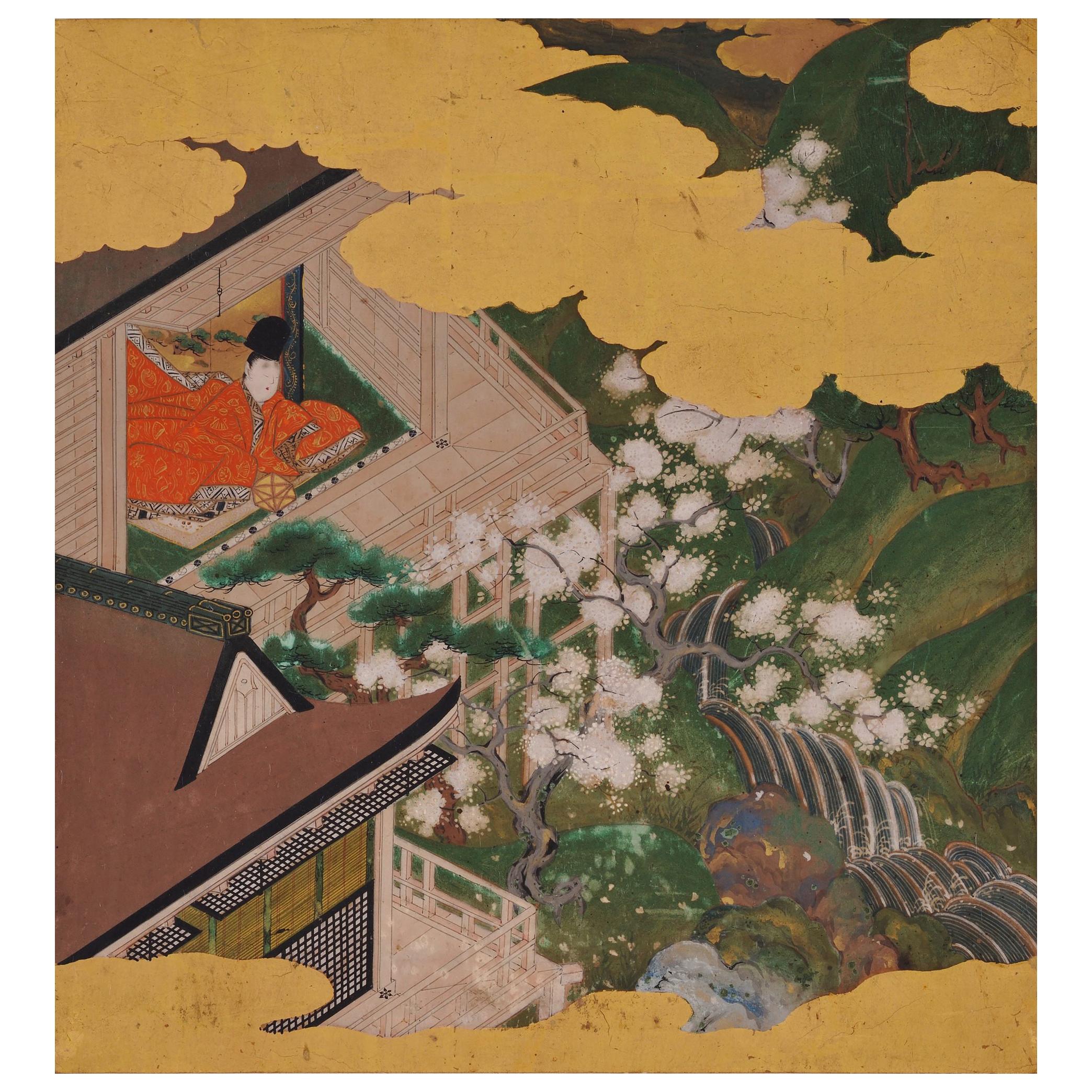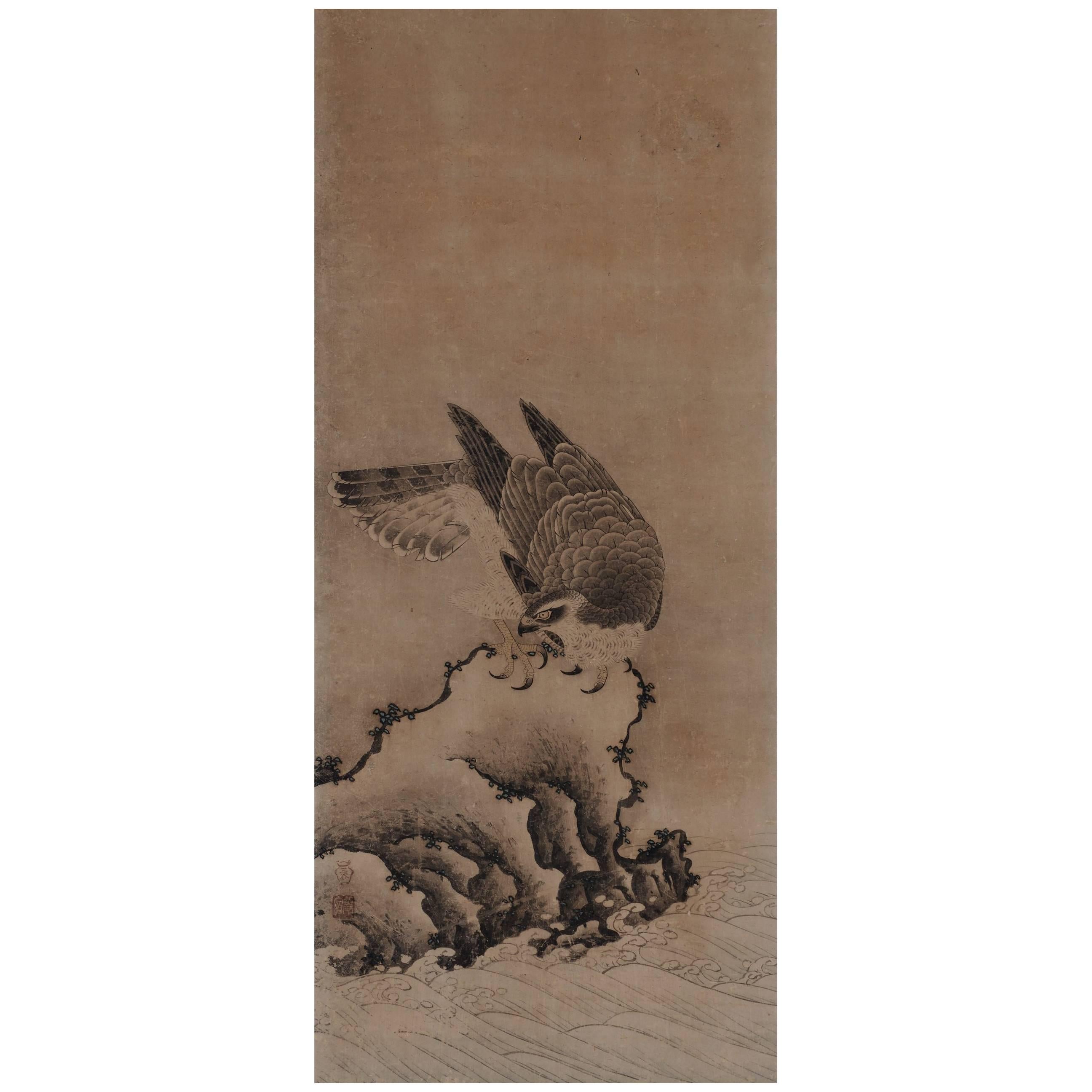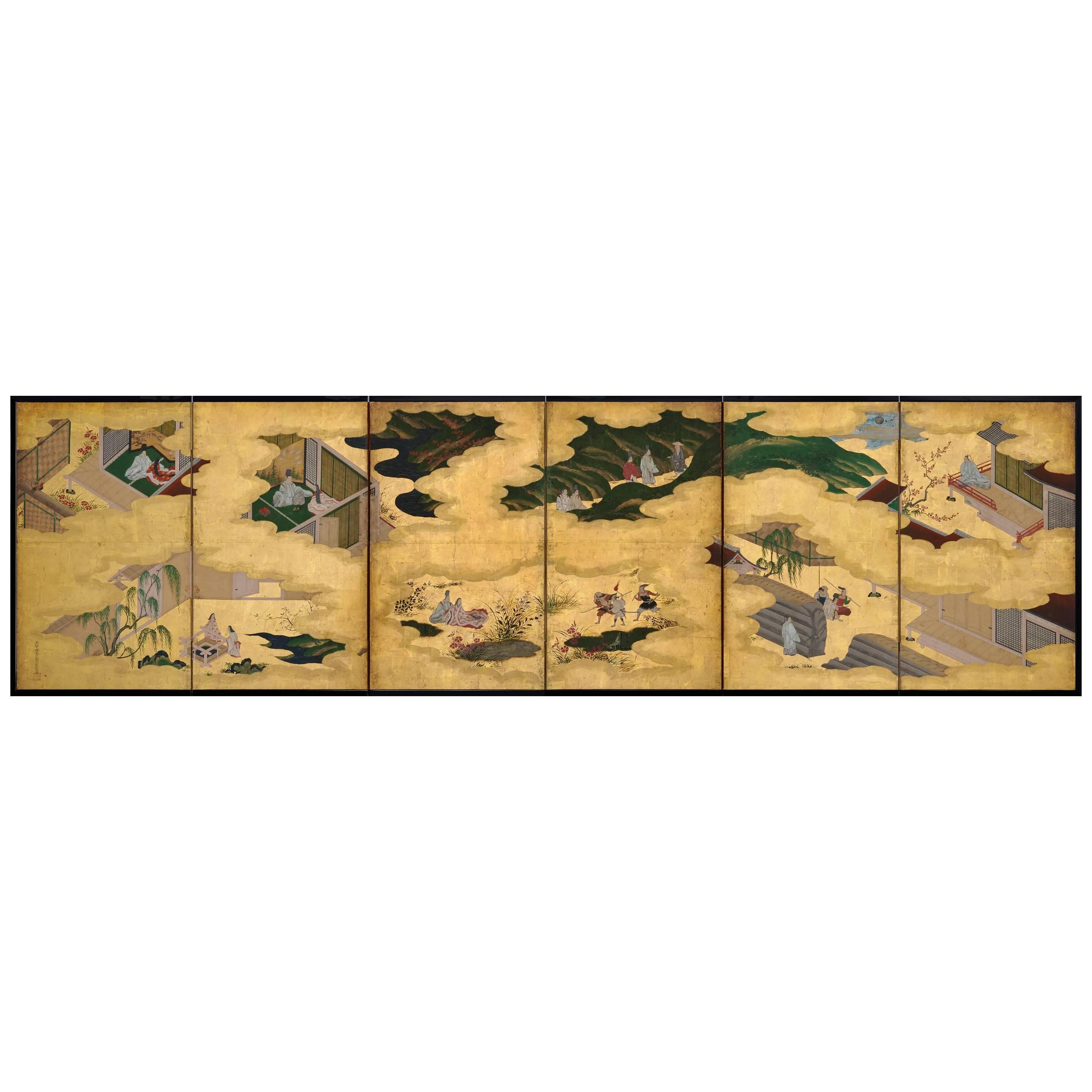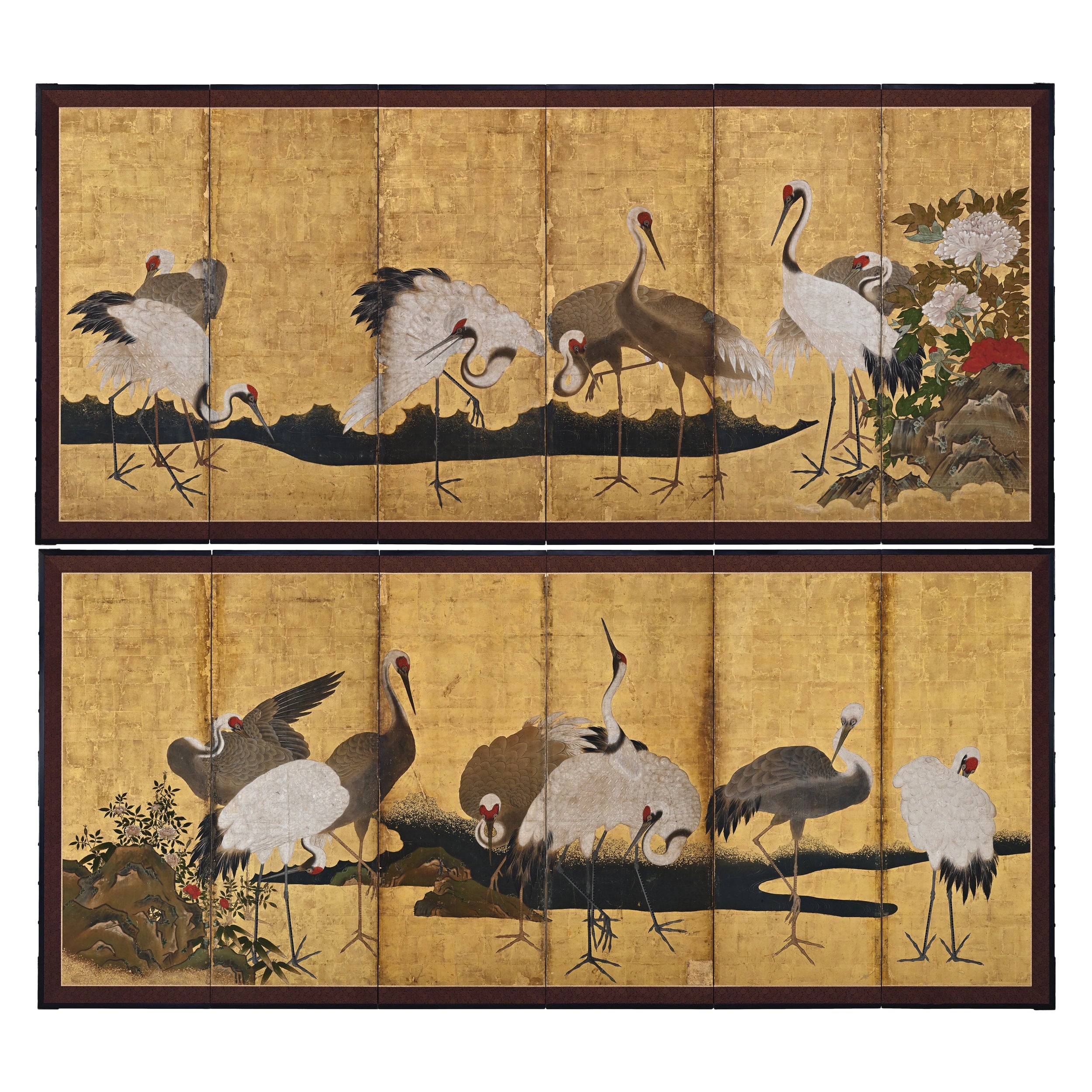Items Similar to Japanese Painting, 17th Century, Tale of Genji, Fujibakama, Tosa School
Want more images or videos?
Request additional images or videos from the seller
1 of 5
Japanese Painting, 17th Century, Tale of Genji, Fujibakama, Tosa School
About the Item
Purple Trousers (Fujibakama), Illustration to Chapter 30 of the Tale of Genji (Genji Monogatari)
Tosa School (second half of the 17th century)
Ink, pigment, gofun and gold on paper. Unframed.
Dimensions:
Approximately 17 cm x 15 cm (6.7” x 6”)
During the seventeenth century, Tosa School artists painted album leaves of Genji scenes in miniature. The viewer is rewarded on close inspection with the delicate facial features of the figures, the intricate patterns on drapery and clothing, and the careful depiction of various flowering trees and grasses. Viewed at a distance, the gold clouds and strong lines of the architecture in the different vignettes work together to form a unifying decorative pattern.
Presented here are individual album leaves from an incomplete set, each illustrating one chapter of the Tale of Genji. Exquisitely painted and beautifully preserved, they date to the mid-17th century. Roofs are entirely removed from houses to reveal small, doll-like figures within. Delicate flowers and plants suggest the seasons of the year. Surrounded by gilded clouds, these graceful paintings shimmer with uncommon beauty and delicacy.
One of the world's greatest literary masterpieces and the finest achievement of classic Japanese prose narrative, The Tale of Genji, written by Murasaki Shikibu shortly after 1000 A.D., has provided endless inspiration for Japanese painters throughout the centuries. The Tale of Genji weaves a vivid depiction of aristocratic life in Heian Japan, which centres on the amorous exploits and political gameplay of the nobility.
Fujibakama (Purple Trousers) is a playful name for a lavender flower that blooms in fall. In the episode most frequently chosen for illustration from this chapter, Yuugiri (Genji's son), comes in the autumn to deliver a letter of condolence to Tamakazura on the death of a relative. He pushes a letter, tied to a spray of Fujibakama in bloom, under her curtain and makes clear through a poem his romantic intentions. Tamakazura’s poetic reply indicates that she does not wish Yuugiri to come any closer.
- Dimensions:Height: 6.7 in (17.02 cm)Width: 6 in (15.24 cm)Depth: 0.1 in (2.54 mm)
- Style:Edo (Of the Period)
- Materials and Techniques:
- Place of Origin:
- Period:Late 17th Century
- Date of Manufacture:circa 1650-1700
- Condition:Wear consistent with age and use.
- Seller Location:Kyoto, JP
- Reference Number:1stDibs: LU2472312639442
About the Seller
5.0
Recognized Seller
These prestigious sellers are industry leaders and represent the highest echelon for item quality and design.
Gold Seller
These expertly vetted sellers are highly rated and consistently exceed customer expectations.
Established in 2001
1stDibs seller since 2016
59 sales on 1stDibs
Typical response time: 5 hours
- ShippingRetrieving quote...Ships From: Kyoto, Japan
- Return PolicyA return for this item may be initiated within 10 days of delivery.
More From This SellerView All
- Japanese Painting, 17th Century, Tale of Genji, Tosa SchoolLocated in Kyoto, JPIllustration to an unidentified chapter of the Tale of Genji (Genji Monogatari) Tosa School (second half of the 17th Century) Ink, pigment, gofun and...Category
Antique Late 17th Century Japanese Edo Paintings and Screens
MaterialsGold Leaf
- Japanese Painting, 17th Century, Tale of Genji, Makibashira, Tosa SchoolLocated in Kyoto, JPThe Handsome Pillar (Makibashira), Illustration to Chapter 31 of the Tale of Genji (Genji Monogatari) Tosa School (second half of the 17th Century) I...Category
Antique Late 17th Century Japanese Edo Paintings and Screens
MaterialsGold Leaf
- 17th century Japanese Falcon Painting, Mitani Toshuku, Unkoku SchoolBy Mitani ToshukuLocated in Kyoto, JPMitani Toshuku (1577-1654) “Falcon” Wall panel, ink and light color on paper. Upper Seal: Mitani Lower Seal: Toshuku Dimensions: Each 118.5 cm x 51 cm x 2 cm (46.5” x 20” x .75”) Individual falcon paintings by Mitani Toshuku (1577-1654), an early artist of the Unkoku School. Founded by Unkoku Togan (1547–1618), a master of the Momoyama period, the Unkoku school enjoyed long lasting patronage in southern Japan. Togan was a retainer of the Mori family in present day Yamaguchi prefecture. Members of the school considered themselves to be in the artistic lineage of Sesshu Toyo...Category
Antique Early 17th Century Japanese Edo Paintings and Screens
MaterialsPaper
- Japanese Screen Painting, Circa 1700 'Tales of Ise' by Tosa MitsusukeBy Tosa Mitsusuke 1Located in Kyoto, JPA six-fold Japanese screen by Tosa Mitsusuke (1675-1710), Japan 17th-18th century, Edo period. The signature reads Shoroku-i ge Tosa sa Konoe Shogen Mit...Category
Antique Late 17th Century Japanese Edo Paintings and Screens
MaterialsGold Leaf
- 17th Century Japanese Screen Pair, CranesLocated in Kyoto, JPCranes Anonymous, Kano School. Edo period, second half of the 17th century. Pair of six-panel screens. Ink, pigment gofun and gold l...Category
Antique 1670s Japanese Edo Paintings and Screens
MaterialsGold Leaf
- Japanese Painting, Framed Panel, 17th Century Falcon by Mitani ToshukuBy Mitani ToshukuLocated in Kyoto, JPMitani Toshuku (1577-1654) “Falcon” Wall panel, ink and light color on paper. Upper seal: Mitani Lower seal: Toshuku Dimensions: Each 118.5 cm x 51 cm x 2 cm (46.5” x 20” x .75”) Individual falcon paintings by Mitani Toshuku (1577-1654), an early artist of the Unkoku School. Founded by Unkoku Togan (1547–1618), a master of the Momoyama period, the Unkoku school enjoyed long lasting patronage in southern Japan. Togan was a retainer of the Mori family in present day Yamaguchi prefecture. Members of the school considered themselves to be in the artistic lineage of Sesshu Toyo...Category
Antique Early 17th Century Japanese Edo Paintings and Screens
MaterialsWood, Paper
You May Also Like
- Important Japanese six-fold screen depicting The Tale of The Genji, 17th centuryLocated in Amsterdam, NLAn important Japanese six-fold screen, depicting episodes from The Tale of The Genji Edo period, 17th century Ink and colour on gilded paper, H. 155 x W. 380 cm The Tale of Genji...Category
Antique 17th Century Japanese Edo Paintings and Screens
MaterialsPaint, Paper
- Japanese Six Panel Screen: Tosa School Painting of Theatre SceneLocated in Hudson, NYwith thought to be Izumo no Okuni (1578-1613). Mineral pigments and gold dust on mulberry paper with silk brocade border.Category
Antique 18th Century Japanese Paintings and Screens
MaterialsGold
- 17th Century Japanese Two-Panel Screen, Gibbons of FolkloreLocated in Hudson, NYJapanese two-panel screen: Gibbons of Folklore, Edo period (17th century) Kano School painting of gibbons in Japanese fables. The left panel represents a Japanese fable of a monkey a...Category
Antique Late 17th Century Japanese Edo Paintings and Screens
MaterialsSilk, Wood, Paper
- Meiji Era Japanese Two Panel Hand Painted Wood Table Screen Tale of GenjiLocated in Studio City, CAA Meiji era Japanese two-panel wood screen, with illustrated images from The Tale of Genji that are exquisitely painted directly on wood with fine detail and precision, accented with scattered 24k gold leaf specks in cloud forms, rendered in the manner of Heian period...Category
Antique 19th Century Japanese Meiji Paintings and Screens
MaterialsGold Leaf
- Late 17th-Early 18th Century Japanese Six-Panel Screen, Battle at Uji BridgeLocated in Hudson, NYJapanese six-panel screen: Battle at Uji Bridge, the first battle at Uji was in 1180 and it marked the start of the Heike Wars. The Genji troops crossed the...Category
Antique Late 17th Century Japanese Edo Paintings and Screens
MaterialsGold Leaf
- Tosa School ca 1700 Scene Edo Period Scroll Japan 17/18c Artist Tosa MitsunariLocated in Amsterdam, Noord HollandAround the middle of the Edo period, say to have been drawn in Tosa Mitsunari of the hands of the Tosa School, the Heian period of person (noble?) Is watching the birds fly the gard...Category
Antique 18th Century Japanese Edo Paintings and Screens
MaterialsSilk
Recently Viewed
View AllMore Ways To Browse
Japanese Gold Paintings
Japan Gold Painting
School House Furniture
Japanese Paintings On Gold
Antique Japanese Painting
Antique Japanese Paintings
Mid Century Japanese Paper
Japanese Paper Painting
Asia Gold Painting
Asian Painting Gold Art
Tree Painting Japan
Japanese Painting Tree
Screen Clothing
Gold Leaf Painting Japan
Japanese Painting Gold Leaf
Japanese Small House
Japanese Painting On Gold Leaf
Japanese Painting With Gold Leaf





